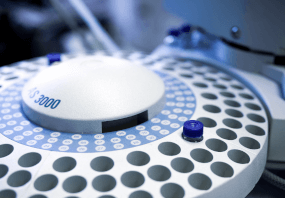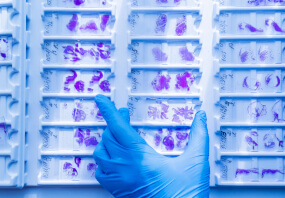General description
Epithelial discoidin domain-containing receptor 1 (EC 2.7.10.1; UniProt Q08345; also known as CD167 antigen-like family member A, CD167a, Cell adhesion kinase, Discoidin receptor tyrosine kinase, Epithelial discoidin domain receptor 1, HGK2, Mammary carcinoma kinase 10, MCK-10, Protein-tyrosine kinase 3A, Protein-tyrosine kinase RTK-6, TRK E, Tyrosine kinase DDR, Tyrosine-protein kinase CAK) is encoded by the DDR1 (also known as CAK, EDDR1, MCK10, NEP, NTRK4, PTK3A, RTK6, TRKE) gene (Gene ID 780) in human. Discoidin domain-containing receptors (DDRs) belong to the superfamily of transmembrane receptor tyrosine kinases (RTKs). DDRs are distinguished from other RTKs by their extracellular discoidin motif and their utilization of collagens as internal ligands. While DDR1 binds essentially all types of collagens, DDR2 shows a preference for type I, II and III fibrillar collagens, and nonfibrillar type X collagen. DDR1 is widely expressed in epithelial cells in lung, kidney, colon, and brain, whereas DDR2 is primarily expressed in mesenchymal cells including fibroblasts, myofibroblasts, smooth muscle cells, and chondrocytes in kidney, skin, lung, heart, and connective tissues. DDRs are important mediators of fundamental cellular processes, such as proliferation, survival, differentiation, adhesion and matrix remodeling, their dysregulations are reported to cause a number of human diseases, including fibrotic disorders, atherosclerosis and cancer. DDR1 is initially produced with a signal peptide sequence (a.a. 1-20), the removal of which yields the mature protein with an extracellular region (a.a. 21-417) that contains the Discoidin domain (F5/8 type C domain or C2-like domain) at the N-terminal half (a.a. 31-185) and a collagen-binding site within the membrane-distal DS domain (a.a. 192-367), followed by a transmembrane segment (a.a. 418-438) and a cytoplasmic region (a.a. 439-913) that harbors a WW domain-interacting PPxY motif (a.a. 481-484) and the kinase domain (a.a. 610-905). Alternative splicings produce five isoforms, isoforms 2 (CAK II, DDR1a, Short) and 5 are expressed with a truncated cytoplasmic domain, while isoform 3 (DDR1d) is expressed in a 243-a.a. soluble form and isoform 4 is expressed with a 6-a.a. insertion (SFSLFS) between Ala665 and Arg666 of the canonical isoform 1 (CAK I, DDR1b) sequence.
Specificity
Clone 5D5 bound recombinant human DDR1b extracellular domain without affinity toward DDR2 extracellular domain or DDR1b membrane-distal DS domain containing the collagen-binding site (Carafoli, F., et al. (2012). Structure. 20(4):688-697). Clone 5D5 does not recognize denatured DDR1b and therefore is not suitable for Western blotting application.
Immunogen
Epitope: extracellular domain
Recombinant human DDR1b extracellular domain.
Application
Immunocytochemistry Analysis: 10 µg/mL from a representative lot detect detected CD167a/DDR1 on the surface of 3% paraformaldehyde-fixed, 0.1% Triton X-100-permeabilized human neonatal foreskin keratinocytes (Courtesy of Birgit Leitinger, Ph.D., Imperial College, London, United Kingdom).
ELISA Analysis: A representative lot bound immobilized recombinant human DDR1b extracellular domain (Kd ~2 nM) without affinity toward DDR2 extracellular domain or DDR1b membrane-distal DS domain containing the collagen-binding site (Carafoli, F., et al. (2012). Structure. 20(4):688-697).
Flow Cytometry Analysis: A representative lot detected the exogenously expressed DDR1b wild-type and mutant constructs on the surface of transfected HEK293 cells (Carafoli, F., et al. (2012). Structure. 20(4):688-697).
Neutralizing Analysis: A representative lot inhibited collagen-induced autophosphorylation of DDR1b exogenously expressed on the surface of transfected HEK293 cells (Carafoli, F., et al. (2012). Structure. 20(4):688-697).
Research Category
Cell Structure
This mouse monoclonal Anti-CD167a/DDR1, clone 5D5 Antibody, Cat. No. MABT333 is validated for use in ELISA, Flow Cytometry, Immunocytochemistry, and Neutralization applications.
Quality
Evaluated by Flow Cytometry in T47D human breast cancer cells.
Flow Cytometry Analysis: 0.1 µg of this antibody detected CD167a/DDR1 on the surface of one million 2% paraformaldehyde-fixed T47D human breast cancer cells.
Target description
99.18/101.1 kDa (mature/pro-isoform 1, CAK I, DDR1b), 95.22/97.17 kDa (mature/pro-isoform 2, CAK II, DDR1a, Short), 25.18/27.13 kDa (mature/pro-isoform 3, DDR1d), 99.84/101.8 kDa (mature/pro-isoform 4), 97.11/99.06 kDa (mature/pro-isoform 5) calculated.
Physical form
Format: Purified
Protein G purified.
Purified mouse IgG1 in PBS without preservatives.
Storage and Stability
Stable for 1 year at -20°C from date of receipt.
Handling Recommendations: Upon receipt and prior to removing the cap, centrifuge the vial and gently mix the solution. Aliquot into microcentrifuge tubes and store at -20°C. Avoid repeated freeze/thaw cycles, which may damage IgG and affect product performance.
Other Notes
Concentration: Please refer to lot specific datasheet.
Disclaimer
Unless otherwise stated in our catalog or other company documentation accompanying the product(s), our products are intended for research use only and are not to be used for any other purpose, which includes but is not limited to, unauthorized commercial uses, in vitro diagnostic uses, ex vivo or in vivo therapeutic uses or any type of consumption or application to humans or animals.
- UPC:
- 51172905
- Condition:
- New
- Availability:
- 3-5 Days
- Weight:
- 1.00 Ounces
- HazmatClass:
- No
- MPN:
- MABT333












